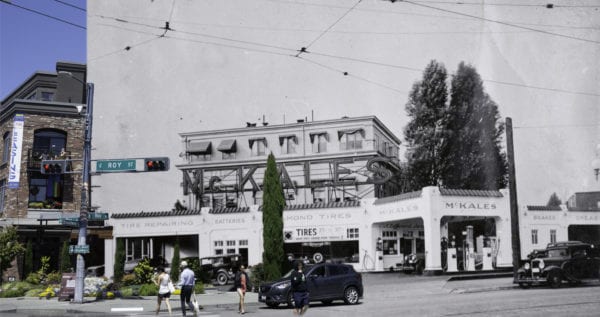
McKale’s Super Service station at Broadway and Roy. The Seven Hundred Broadway Building today houses apartments over Roy Street Coffee and other businesses (1937: Washington State Archives; 2016: Rob Ketcherside)
Winning the War on Cars
There just aren’t as many gas stations as there used to be. The economics have changed. People drive less, cars use less fuel. I looked through the 1931 city directory. There were at least 33 gas stations on Capitol Hill back then. There were so many more no matter which way you drove: on Eastlake, on First Hill, in Madison Park, at Portage Bay, on Westlake. Today Capitol Hill, Broadway, Pike/Pine, heck you can go way out Madison and there are still only seven stations.
In 1990, the Seattle Times ran an article about a new law requiring gas stations to carry insurance against environmental damage. Before that law took effect, they reported there were already only half as many stations as in 1974. Even more closed afterwards.
And they keep disappearing. Recently I was going through my old photographs and found this look down at Pine and Broadway in 2000. I’ll be honest, I have no memory of this Chevron. I remember it as a lot surrounded by chain link and then at last the Walgreens and Capitol Hill Housing building we have now. (If you have better memory of the station, leave a comment!) I’m pretty sure the station at Pike and Broadway is living on borrowed time. The land is too valuable as a people-oriented use.

Chevron gas station at Broadway and Pine, 2000. Full view here. (Photo: Rob Ketcherside)
Back to the economics angle. These stations used to make money as mechanics too. Cars break down much less often now, so there are very few stand-alone garages, let alone gas stations with garages. Back when gas stations were still service stations, you chose between “self serve” or a slightly higher price for “full serve”. Someone pumped the gas for you and washed your window and checked your tire pressure and oil. We constantly checked oil back then because it leaked out hoses, out of engine blocks, out of everywhere. I’m talking about the 1990s here, recent history. I can’t even remember when full service disappeared.
But imagine this. What if there were something even better for drivers than a service station? What if there were a… super service station?
McKale’s Super Service Station
Yes, indeed. The heading says it all. There were super service stations, we had one on Broadway, and it was part of a chain called McKale’s.
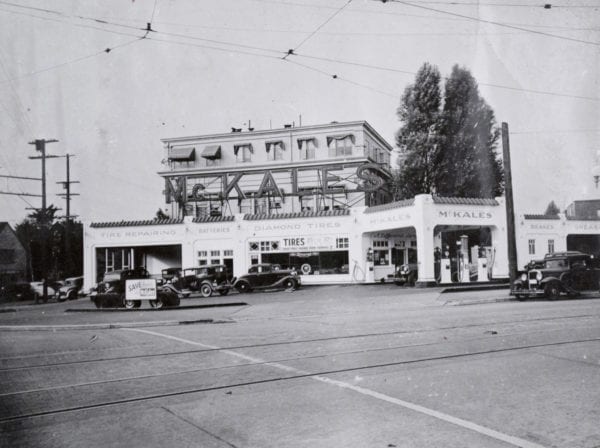
McKale’s Super Service Station, Broadway and Roy, 1937 (Washington State Archives. But shout out to Tom Heuser for getting a copy of it for me while he was there doing research for the Capitol Retrospective series!)
First, super service stations.
Super service stations got their start in Los Angeles in 1914. They were a combination of several nascent automobile business types, all in one convenient location. They had facilities for fueling, tire repair, engine repair, and other maintenance. You could buy car accessories like chrome skull gear shifters, Keep on Truckin mud flaps, sheepskin seat covers, and 20 foot antennas for great CB reception. They were the first business to adopt a set-back from the street, allowing cars to enqueue or park on the business’s lot instead of searching for street parking. They tended to be L-shaped and present a massive sign or distinctive architecture to attract the eye of passing motorists. Super service stations boomed after the end of World War One and into the 1920s.
(The library has a copy of this great book called The Drive-In, the Supermarket, and the Transformation of Commercial Space in Los Angeles, 1914–1941. You wouldn’t know from the title, but the first third of the book is all about super service stations. I just summarized that part for you in the previous paragraph but there is so much more to know! Also pictures!)
Pine Street Tire Shop, McKale Bros, McKale’s Tire Co
Earl and John H. McKale came from Sheridan, Kansas to Seattle in the mid-nineteen-teens. They first appeared in Seattle in 1916, when Earl McKale was listed as a chauffeur at age 15. His brother John was married and living in Wyoming working as a telephone operator that year.
The McKale business got its start in Seattle in 1917. Earl was joined by John to open a tiny store at 727 Pine Street repairing and retreading worn tires as well as selling used tires. That address is now part of the Convention Center.
Earl remembered later, “My entire stock consisted of ten second-hand tires and three new tires.” Things took off and they called themselves The Biggest Little Tire Shop in Town. In a June 1919 article they boasted, “We were so crowded with work that it was difficult to get around the place.” In a 1927 Seattle Times article Earl reinforced the point, “It was so small that when the boss opened the doors in the morning he had to pile the tires on the sidewalk before he could enter the store.”
That success meant an opportunity to expand, so they moved up four blocks to the southeast corner of Minor and Pine. Today it’s the space that Meltdown Pizza just opened. It’s a door down from Baguette Box and another from the Baltic Room. The promo photo for the move in the Seattle Times was simply captioned “Earl McKale and Staff”. John never appeared much in discussion of the business. I’m guessing that John was in a back-of-the-house role as the store expanded, continuing to deal directly with the tire repair while Earl took on more aspects of running the business.
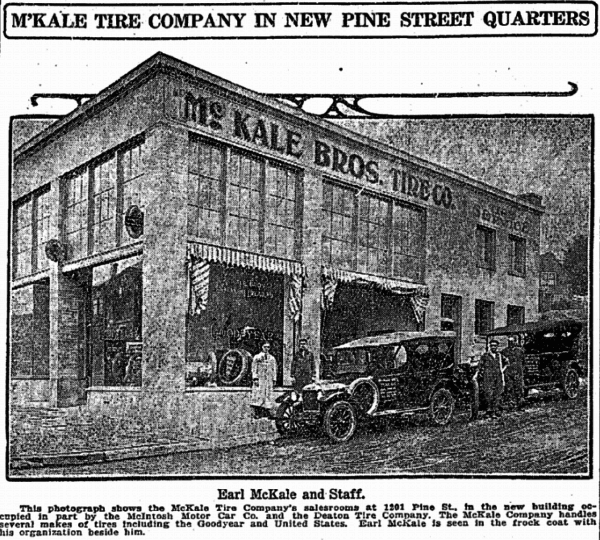
McKale Brothers’ Tire Shop (July 6, 1919 Seattle Times)
By 1921 they joined a large number of independent resellers of Goodyear tires. Earl was voted vice president of a new Seattle Goodyear dealers association in December. A few short months later the McKales switched to another brand, becoming the local distributor of Seiberling tires. The shift in business led to articles and photographs in at least the Seattle Star and Seattle Times, if not other newspapers.
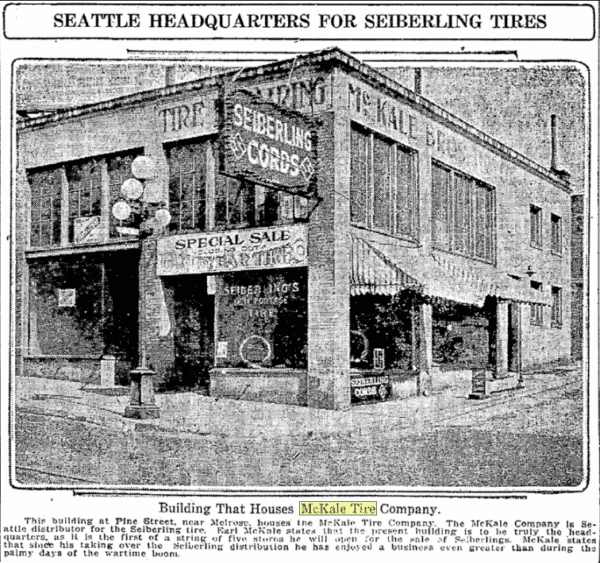
McKale Brothers Tire Company at Broadway and Minor in 1922 advertising Seiberling (July 11, 1922 Seattle Times)
A new business venture
John left Seattle in 1922 or 1923, returning to Kansas. He left the automotive industry as well, returning to operating telephones and later working at a refrigerator company. If John’s departure didn’t coincide with the switch to Seiberling distribution, perhaps it was just after, when McKale’s relocated and underwent a massive change in services.
In November 1922 McKale’s reopened after a short move to 8th and Union. The business now occupied its own, new building. It was inspired by trends in Los Angeles and by a realization by Earl that in retrospect seems obvious in a hilly city: “It became evident to me that proper tire service could not be given in the street.”

McKale’s 8th and Union (Seattle Times, December 3, 1922)
The new building allowed customers to pull off-street into a number of special-purpose maintenance sheds. There was parking space on the lot for cars waiting for service. And the new super service station aimed to attract customers for all of their regular needs. McKale’s sold gasoline, was ready to fill tires and radiators, and sold frills and supplies that brought people back whenever there was the slightest excuse, like scented evergreen trees, fuzzy dice, whitewall bleach, and bullhorn hood ornaments. (That last part isn’t true. Wait, did you believe me about chrome skull gear shifters too?)
The Seattle Times billed it the “First Super-Service” station. Of course there were dozens or hundreds in Los Angeles already, so they meant the first locally. It was built on the Los Angeles model, L-shaped with entrances from two streets. It was also attractive, with red tiled roofs and small but purposeful landscaping.
Expansion and Broadway and Roy
Earl McKale patted himself on the back in 1927, “Ten years ago I had a stock of three new tires and today McKale’s Inc. handles more than twelve [train] carloads of Seiberling cord tires a year and from eighteen to twenty [train] carloads of gasoline a month.”
By that point the station had turned into a small chain. First he built a warehouse for tire and gasoline storage alongside a super service station in Smith Cove in 1925. Stores in Fremont and the University District followed.
Growth continued steadily. In 1928 the fifth store opened at 17th and Madison, across from the current Shell station where Trader Joe’s is today. Another opened in 1929. And then the strength of McKale’s business model proved itself. They flourished after the onset of the Great Depression, perhaps filling gaps as other stations closed.

Aerial view of McKale’s station number 5 at 17th and Madison in 1936. Currently the location of apartment building with Trader Joe’s. (King County iMap)
The Broadway and Roy store opened in September 1931. Like other stores it had ample room for vehicle maintenance and it had a big showy facade. A massive sign with “McKales” in neon stood on the roof, which cost $1000 to install. The assessor’s report described the building as “just a cheap frame building with a good front on it.”
San Francisco
The nicest of the super service stations are truly architecturally interesting. In 1932 McKale’s began opening stores in San Francisco. The first store, at 1600 Mission Street, has been listed as a candidate for landmarking under the National Register of Historic Places.
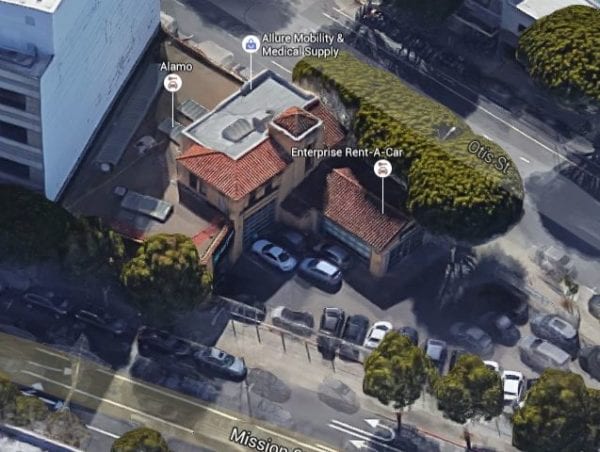
Tilt view of 1600 Mission Street in San Francisco from the east. This was McKale’s first Bay Area station. (Google)
The McKale’s chain spread through the Bay Area and Seattle from the 1930s, outliving Earl McKale. He passed away in 1953, but the McKale family continued running their tire, fuel and service chain. Finally in 1964 the corporation was acquired by Union Oil (Unocal or Union 76). For more than three decades McKale’s wa the biggest independent seller of Union gasoline, and Union wanted to keep them in the fold.
One of the San Francisco McKale’s stores is linked to Jack Kerouac’s semi-autobiographical novel On the Road, the book that set the bar for American road trips. Kerouac later said that a letter to him by Neal Cassady in 1950 inspired the style of the book. In another letter from Cassady, back in 1947 when Kerouac was just starting to gather material for On the Road, McKale’s made an appearance.
Let me proclaim: I am now working, what a business! god, you wouldn’t believe it even if you saw it; picture I.B.M. at its worst and double that to receive a faint portrait of the company I work for; McKale’s Inc., a gas station outfit, has 12 of these stations and yet, have, with maddening persistency, succeeded in building up a booming business based on “smiling cooperation” and “cheerful service,” so these 12 stations now take in more than any other 12 in town. This is maintained by high-pressure selling and all who work for the company take courses and read massive journals full of “the proper method.” I can’t go on — impossible to describe; much too funny to tell, you’d have to see it. (November 1947 letter. Neal Cassady, Collected Letters, 1944-1967)
It should be safe to assume that Jack Kerouac visited a McKale’s. Cassady mentioned McKale’s again in a long letter that he added to continually for six months before finally mailing in June 1948.
Jan 20 — Quit my job at McKales — was really out of my head at this time — got so saturated with grief would tear across busy blvd. intersections at 50, right thru the stop sign — hoping to get hit.
Ruins of empire
Between the two cities, most of the former McKale’s locations have been redeveloped. There are a few that continue to operate as 76 stations. But they all have modern structures that replaced the originals.
That’s what happened at Broadway and Roy. Then the replacement too was demolished and lay empty with just a shadow outline of the super service station in concrete, visible in aerial photographs. After a number of years the Seven Hundred Broadway Building was at last constructed.
So what is left? As far as I can tell, there is the 1600 Mission building in San Francisco, and then there is one former McKale’s left in Seattle. It is at 76th and Aurora, next to the PCC. Today it’s International Service Centre. The gas station is gone, but the L-shaped garage is still being used by mechanics. It was store number 18 and quite different architecturally from other stores in the chain.

McKale’s service station number 18 opened at 76th and Aurora in 1935. It is the only remaining McKale’s structure in Seattle. (May 12, 1935 Seattle Times)
In the hot real estate markets of San Francisco and New York, people have already started noticing a dramatic reduction in gas stations. San Francisco expects to have almost half as many gas stations in 2017 as they did in 2007. San Francisco developer Brian Spiers gave a clear image of the future of the gas station in a 2014 SF Gate article. He said, “The whole gas station experience needs to go away in the urban environment.”
Seattle will have at least one building to remember gas stations by. The Firestone tire service center in SLU, which began as a super service station, was designated a city landmark last month. For many years it was in direct competition with a McKale’s three blocks away. Now there is nowhere to buy gasoline in that neighborhood.